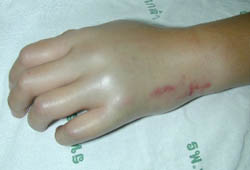小结
定义
病史和体格检查
关键诊断因素
- identification of the snake
- local redness, swelling, tenderness, and pain at wound site
- blurred or double vision
- shortness of breath
- difficulty swallowing
- hypotension
- tachypnea
- tachycardia
- puncture marks, fang marks
- bulbar weakness/paralysis
- stridor
- hemorrhage
- quadriplegia/locked-in syndrome
其他诊断因素
- nausea and vomiting
- malaise, generalized weakness or dizziness
- perioral tingling or numbness
- urticaria
- tremors
危险因素
- male sex
- alcohol consumption
- intentional snake encounter
诊断性检查
首要检查
- prothrombin time, PTT, fibrinogen, and D-dimer
- CBC
- electrolytes, BUN, and creatinine
- arterial blood gas
- creatine kinase (CK)
- lactate
- urinalysis
- ECG
- chest x-ray
- wound x-ray
- negative inspiratory force (NIF) test
需考虑的检查
- CT/MRI
- compartment pressure
- central venous line with central venous pressure (CVP) transduction
- arterial line with pressure transduction
治疗流程
presumed snakebite
confirmed snakebite
撰稿人
作者
David Vearrier, MD, MPH, FAAEM, FACMT, FAACT

Professor of Emergency Medicine
Division of Medical Toxicology
Department of Emergency Medicine
Program Director, Medical Toxicology Fellowship
Associate Program Director, Preventive Medicine Residency
Co-Director, Student and Employee Health
Department of Preventive Medicine
University of Mississippi Medical Center
Jackson
MS
利益声明
DV declares that he has no competing interests.
鸣谢
Prof. David Vearrier would like to gratefully acknowledge Prof. Michael Greenberg, previous contributor to this topic. MG declared that he had no competing interests.
同行评议者
Scott Phillips, MD
Associate Clinical Professor of Medicine
Department of Clinical Pharmacology and Toxicology
University of Colorado
Health Science Center
Denver
CO
利益声明
SP has a professional relationship with Michael Greenberg, one of the original contributors to this topic. They are partners in a private consulting company. SP does not receive money from him, nor does he receive money from SP.
Donna Seger, MD
Medical Director TN Poison Center
Associate Professor of Medicine and Emergency Medicine
Vanderbilt University Medical Center
Nashville
TN
利益声明
DS declares that she has no competing interests.
Senanayake Kularatne, MBBS, MD, MRCP, FRCP, FCCP
Professor
Department of Medicine
Peredeniya University
Sri Lanka
利益声明
SK declares that he has no competing interests.
Peer reviewer acknowledgements
BMJ Best Practice topics are updated on a rolling basis in line with developments in evidence and guidance. The peer reviewers listed here have reviewed the content at least once during the history of the topic.
Disclosures
Peer reviewer affiliations and disclosures pertain to the time of the review.
参考文献
关键文献
Kanaan NC, Ray J, Stewart M, et al. Wilderness Medical Society practice guidelines for the treatment of pitviper envenomations in the United States and Canada. Wilderness Environ Med. 2015 Dec;26(4):472-87.全文 摘要
Hewett Brumberg EK, Douma MJ, Alibertis K, et al. 2024 American Heart Association and American Red Cross guidelines for first aid. Circulation. 2024 Dec 10;150(24):e519-79.全文 摘要
Lavonas EJ, Ruha AM, Banner W, et al. Unified treatment algorithm for the management of crotaline snakebite in the United States: results of an evidence-informed consensus workshop. BMC Emerg Med. 2011 Feb 3;11:2.全文 摘要
参考文献
A full list of sources referenced in this topic is available to users with access to all of BMJ Best Practice.

鉴别诊断
- Anaphylaxis
更多 鉴别诊断指南
- 2024 American Heart Association and American Red Cross guidelines for first aid
- Wilderness Medical Society practice guidelines for the treatment of pitviper envenomations in the US and Canada
更多 指南登录或订阅即可浏览 BMJ Best Practice 临床实践完整内容
内容使用需遵循免责声明